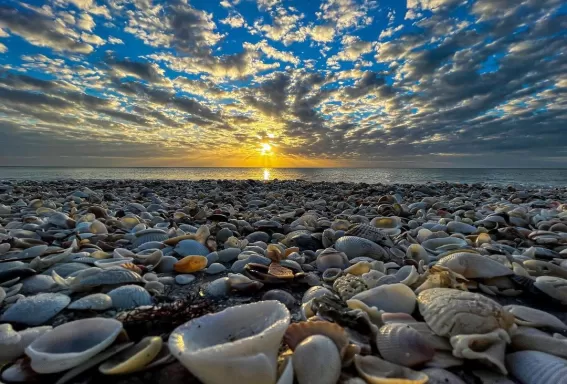Seashells 101: How and Where to Find the Best Shell Souvenirs
Fort Myers is the birthplace of National Seashell Day, which coincides with the first day of summer, and locals love to “shell-ebrate” all year long.
Thanks to the gentle surf and a flat undersea shelf, seashells wash up on our shores in whole, pristine conditions. These beautiful shells are replenished every day, which is why Sanibel Island has been named the seashell capital of the world.

When you see people shell collecting or beach combing, that’s what we call “shelling.” They’re often bent over to get a closer look, which is what we call the “Sanibel Stoop” or the “Captiva Crouch.”
The appeal of this destination is that beaches full of shells are plentiful. That includes Bowman’s Beach, Blind Pass Beach, and Lighthouse Beach on Sanibel Island, and Turner Beach on Captiva Island. Only accessible by boat, Cayo Costa State Park and North Captiva are also abundant with shells.

While you can collect seashells any time of day, low tide in the early morning hours is the most productive time. That’s when shells are fully exposed on the sand, and you could be among the first to stumble into the biggest and most diverse collections. When you pair strong winds with a full moon, the beaches are practically overflowing with seashells.
The sun is strong, so come ready with sunscreen, a hat, and sunglasses. At certain times, the shoreline can be blanketed in shells, so be sure to wear water shoes to protect your feet. Canvas or mesh reusable bags are great for collecting rather than a heavy bucket, but your hands will do just as well.

Shell-seekers can uncover hundreds of varieties of seashells on these sands, from the common to the exceptionally rare. Here’s a quick guide on what to look for and how to know if you’ve stumbled into something amazing.
One of the Sanibel Six, the lightning whelk, is a popular find. These spiraled, golden-brown beauties are relatively easy to find both in the sand and in deeper waters.
You’ll recognize an alphabet cone from its unique pattern of dashes and dots, often a bright orange or deep brown. Take note: Cone snails are venomous so if you find a live shell, return it carefully.
Large cockle shells are a prized find on these beaches and can easily be transformed into dishes and Christmas tree ornaments when you bring them back home.
Tulip shells are notable for their horizontal lines and rich colors. There’s the banded tulip and the true tulip, which typically grows larger than its counterpart.
The junonia shell is one of the more coveted among collectors. Cream-colored with a distinctive brown spotted pattern, these shells are rare because their inhabitants tend to live in deeper water so they don’t wash up as often.
Want to learn more? Check out the Bailey-Matthews National Shell Museum for deeper insight into the shells of Fort Myers.
When you come to visit Fort Myers, you’re welcome to collect prized shells that catch your eye, but please be mindful of how many you take. They make beautiful souvenirs, can be a part of crafting and jewelry making, and will inspire meaningful memories whenever you look at them. Just make sure you’re not disturbing any creature’s habitat! It is illegal to take live shells, so please examine the shell to make sure nothing is inside; if so, even if you’re not sure, put it back where you found it. Crabs, starfish, sea urchins, and sand dollars are also protected. Be mindful of how many shells you’re gathering so you can leave plenty for others.





